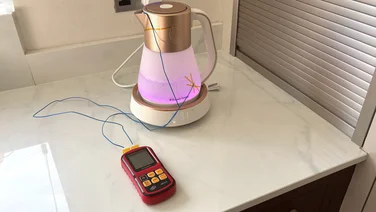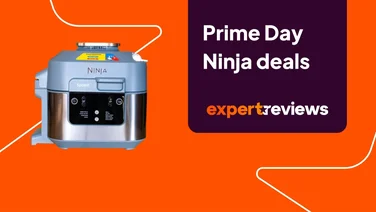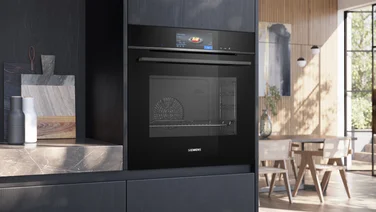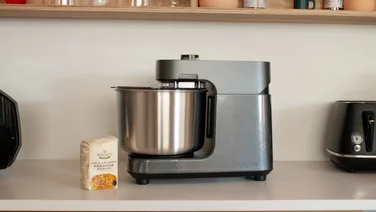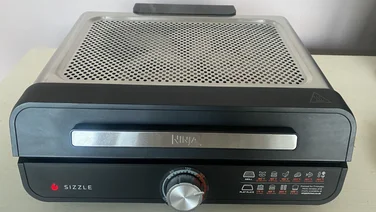To help us provide you with free impartial advice, we may earn a commission if you buy through links on our site. Learn more
- Best knife sharpener: At a glance
- How to choose the best knife sharpener for you
- The best knife sharpeners you can buy in 2023
- 1. AnySharp Knife Sharpener: Best knife sharpener for everyday knives
- 2. Global Knife Sharpener: Best knife sharpener for Asian-style blades
- 3. Joseph Joseph Rota Folding Knife Sharpener: Best space-saving knife sharpener
- 4. Smart Sharp by Lantana: Best knife sharpener under £15
- 5. Kai Shun Damascus Combination Whetstone: Best double-sided whetstone
- 6. Shapton Ceramic Kuromaku #8,000: Best whetstone for high-end knives

We all need kitchen knives that can dice onions without sliding off the skin or destroying our herbs, which is why we’ve tested a range of knife sharpeners for every budget and skill-set.
Even expensive knives will end up blunt after a certain amount of use, so unless you want to battle through carving every Sunday roast, or end up relegating that hundred-pound Santoku beauty to its branded wooden stand, then you need a decent sharpener. Our recommendations for the best knife sharpeners come from looking at price, as well as testing durability, useability and more.
So whether you’re looking for something simple for everyday use or a more want to master the art of sharpening those high-end blades, there’s something for everyone here. It’s just a question of how much you want to spend and how much time you want to invest in learning how to keep your blades as sharp as a razor. With a little effort, you can make your knives last longer and cut better.
You will find our guide to choosing the best knife sharpener below, which will run you through everything you need to know before buying. If you’re already clued up on the different types of sharpeners, then a little further down you will find out top picks in every category.
Best knife sharpener: At a glance
- Best sharpener for everyday knives: AnySharp Knife Sharpener | £13
- Best sharpener for Asian-style blades: Global Knife Sharpener | £45
- Best sharpener under £15: Smart Sharp by Lantana | £9.30
How to choose the best knife sharpener for you
Knife sharpeners come in many forms and work in many different ways. The right choice for you depends on the quality of the kitchen knives that you own, how much you want to spend, and also on the time and effort you’re willing to expend. Your preferred choice may depend on how confident you feel in using the more challenging sharpening methods.
What’s the difference between honing and sharpening?
Restoring the cutting ability of your knives is actually the product of two different actions: honing and sharpening. The process that you will end up doing most regularly is actually honing rather than sharpening, however.
Honing a blade is the process of restoring a perfectly straight cutting edge, it pushes the blade back into position.
Sharpening is something that you will only need to do once you find that honing no longer restores a blade’s cutting ability.
What types of knife sharpener are there?
The sharpening rod or honing steel: In its cheapest guise, the rod is simply a coarsely ridged piece of steel that sharpens your knife, but also rips a good deal of steel off in the process. At the top end, rods can be fine-graded ceramic honing tools – also known as honing steels – which give an excellent finish without taking off more than a smidgen of steel. Technique is paramount with these if you want to preserve the blade. Hold the end of the rod on a base and very carefully draw the blade down at around ten degrees or whatever is most suitable for your blade and sharpener.
The whetstone: Requiring considerable technique to both avoid damaging your knives and achieve the razor-sharp, perfectly-straight edge we’re all looking for, the whetstone sits at the daunting pinnacle of knife sharpening. Understandably, the expense and the fear of getting it wrong can put many people off. However, with a little effort, a combination of different grades of whetstone can rescue even the most damaged of blades.
The V-sharpener: These gadgets are generally held to the kitchen surface with one hand while you draw the blade through a ‘V’ created by two abrasive plates. They can feature one, two or three plates to give different grades of abrasion, thus providing both honing and sharpening as required. A plus point is that almost no technique is required. You can only draw the blade through in one direction, and only overly rough treatment will damage the knife edge.
Electric sharpeners: Once turned on, it spins the sharpening stones, so that when a knife is drawn through the slots, the blades are sharpened simply and effortlessly. Most electric sharpeners have guides to ensure you get the perfect angle, which makes them even more popular. But they’re expensive and give less control than hand sharpeners.
READ NEXT: Stay sharp with our pick of the best kitchen knives you can buy
The best knife sharpeners you can buy in 2023
1. AnySharp Knife Sharpener: Best knife sharpener for everyday knives

Price: £13 | Buy now from LakelandThis is a one-size-fits-all knife sharpener and for the price, it does a decent job – at least with less expensive knives. For standard kitchen knives in need of some serious attention, it will sharpen as well as is needed and give an excellent cutting edge that will rip through anything. It sharpens on both sides when you pull the blade through, so it’s not suitable for single-edged knives unless you don’t mind them becoming double-edged.
One thing we noticed is that you must ensure the surface you stick the suction cups on the base to is airtight. Most kitchen surfaces will be, but gouges and scratches will affect the AnySharp’s ability to hold firm, which could lead to accidents. Be careful. We would hesitate to recommend this for pricier knives, though – you would be advised to buy one of the more refined alternatives below.
Read our full AnySharp Knife Sharpener review
Key specs – Sharpening, honing or both: Sharpening only; Holding method: One-handed (the sharpener attaches to the surface with suckers to an airtight surface so your other hand is left free); Single-edged knives: No
2. Global Knife Sharpener: Best knife sharpener for Asian-style blades

Price: £45 | Buy now from Harts of SturGlobal is one of the best-known kitchen knife brands in the world. Their sleek modern design, which slices through food like butter, makes them attractive to professionals and home chefs alike. This knife sharpener is aimed at keeping them sharp, but it works well on all knives (except ceramic and serrated), especially Asian or Japanese angled blades. You start by filling the base with cold water (to keep the blade cool) then you pass the blade back and forth gently, with no pressure, through the coarse ceramic wheel around seven times, before repeating with the finer wheel. Voila – a knife as sharp as it comes. It’s seriously impressive. There’s a cover to protect it when being stored and Global sells the wheels separately in case you ever need to replace them (unlikely unless you’re a professional chef).
Key specs – Sharpening, honing or both: Sharpening only; Holding method: One-handed (attaches to a smooth surface); Single-edged knives: Yes
3. Joseph Joseph Rota Folding Knife Sharpener: Best space-saving knife sharpener

Price: £20 | Buy now from John Lewis Like so many of Joseph Joseph’s products, this is both lightweight and compact, making it easier to use than many knife sharpeners, as well as easy to store away in a drawer. It achieves this by having a handle that simply folds away after use. And there’s no compromise on efficiency as a result. It’s simple to work: you place the blade in the groove marked “1”, and run it steadily backwards and forwards through the sharpening wheel, applying gentle pressure – repeating ten times for dull blades and 20 for blunt or damaged ones. Then transfer to groove marked “2” and run the blade through five to ten times. Job done. The handle is easy to grip, while the silicone footing prevents it from moving about when in use so it stays safe. A space-saving, easy-to-work ceramic knife sharper, which makes light work of knife sharpening. Great for small kitchens.
Key specs – Sharpening, honing or both: Sharpening; Holding method: Lock handle into position then place on a flat surface and grip handle firmly while the other hand is left free for use when holding the knife; Single-edged knives: Yes
4. Smart Sharp by Lantana: Best knife sharpener under £15

Price: £9.30 | Buy now from AmazonOne of the few sharpeners to offer three grades in one, the Lantana is a well-thought-out product and does the job quickly but incrementally. It’s braced with one hand (it works for right and left-handed people) and then you have a quick three-stage process. First are the coarse diamond plates, which eliminate notches and prepare the knife for the sharpening stage. Next are the tungsten carbide plates, which sharpen the knife to a “V” and finally come the ceramic honing plates to remove burs and straighten the edges. It’s not recommended for use on thinner blades, such as the Global brand, and it will turn single-edged blades into double-edged, but for everything else, this does a good job at a very low price.
Key specs – Sharpening, honing or both: Both; Holding method: Hand-braced on the kitchen surface; Single-edged knives: No
5. Kai Shun Damascus Combination Whetstone: Best double-sided whetstone

Price: £69 | Buy now from Borough Kitchen This double-sided whetstone offers a practical solution to someone who’s serious about their knives but doesn’t fancy filling their cupboard with racks of sharpening stones. The coarse 300-grade will eliminate defects and notches, and then you can flip it over to use the 1,000-grade side, which will hone the knife’s edge. It requires soaking in water for 15 minutes prior to use and so isn’t a quick-fix option for long-blunt knives, but get past that and it’s a professional solution that’s also easy to store and use.
As with all whetstones, you will need to take care when using it. We would suggest the 300 is too coarse for everyday use and will take a fair bit off your knife, so most will be happy using the 1,000-grade regularly, occasionally resorting to the coarser side when your knife collection starts looking a little worse for wear.
Key specs – Sharpening, honing or both: Both; Holding method: One hand on blade, one on knife handle (the stone holds to kitchen surface on its supplied rubber base); Single-edged knives: Yes
6. Shapton Ceramic Kuromaku #8,000: Best whetstone for high-end knives

Price: £67 | Buy now from AmazonNot for the faint-hearted, using a whetstone requires a bit of technique and a lot of money, but the results are worth it. This 8,000 grade stone is excellent for the final sharpening to a (literally) razor’s edge, but we’d recommend also buying two coarser grades, such as the 1,000 (£47) and 5,000 (£59) from Shapton’s Kuromaku range. There’s little better for keeping your kitchen knives in tip-top condition.
If your knife has got really blunt and notched, replace the 5,000 with a coarse 320, then move to the 1,000, and finally work your way up to this 8,000 – you can step up to 12,000 or 30,000 grades if you’re a complete perfectionist. For technique, YouTube has some excellent tutorials. Give yourself some time and try it out on cheap old knives before working your way up to your treasured Japanese folded knives.
Key specs – Sharpening, honing or both: Both; Holding method: One hand on blade, one on knife handle (the stone holds to kitchen surface on its supplied base); Single-edged knives: Yes







